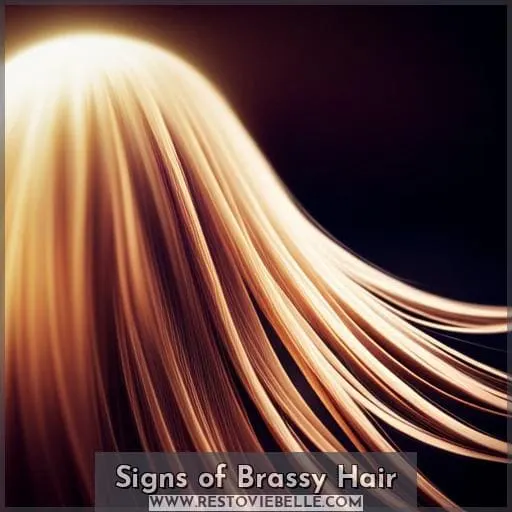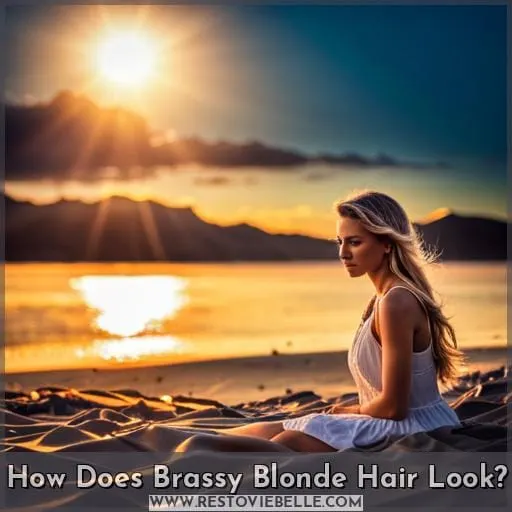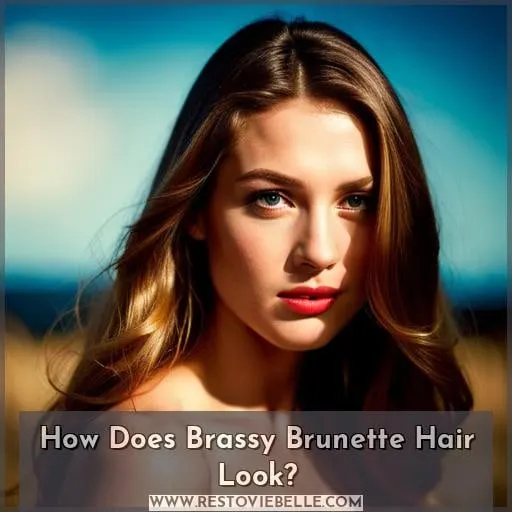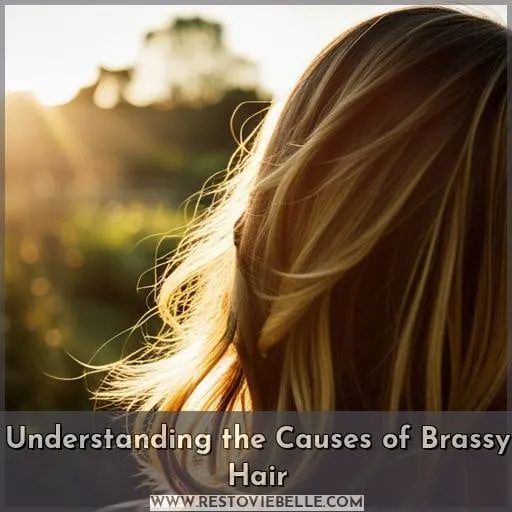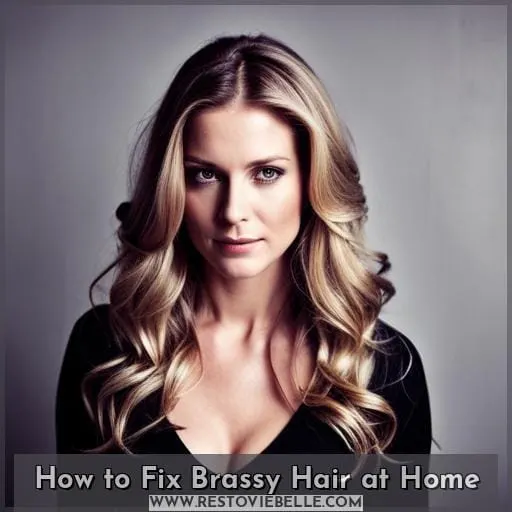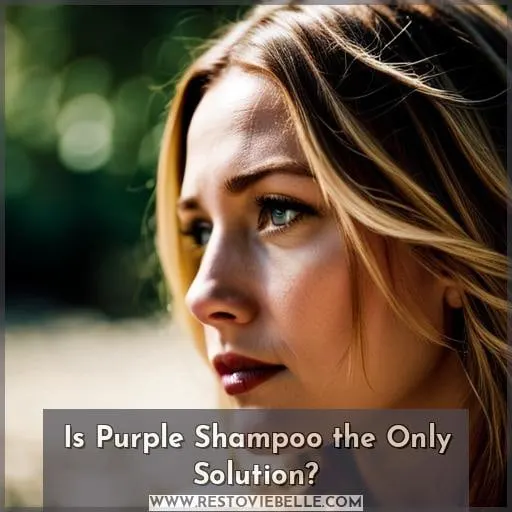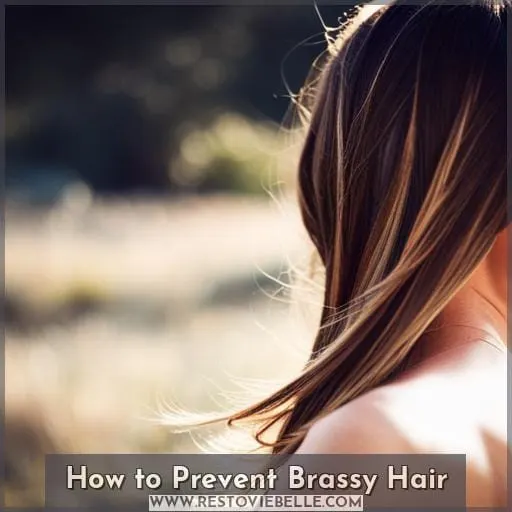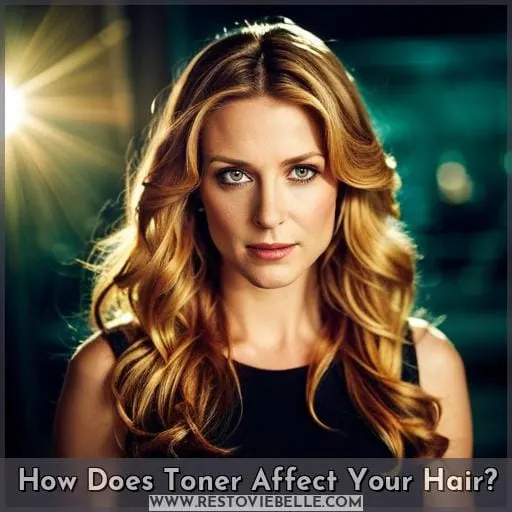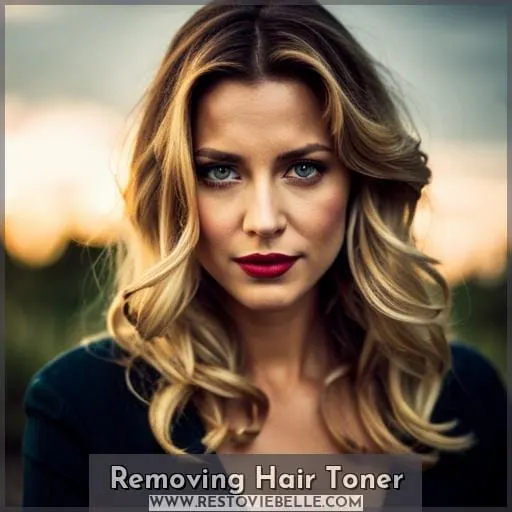This site is supported by our readers. We may earn a commission, at no cost to you, if you purchase through links.
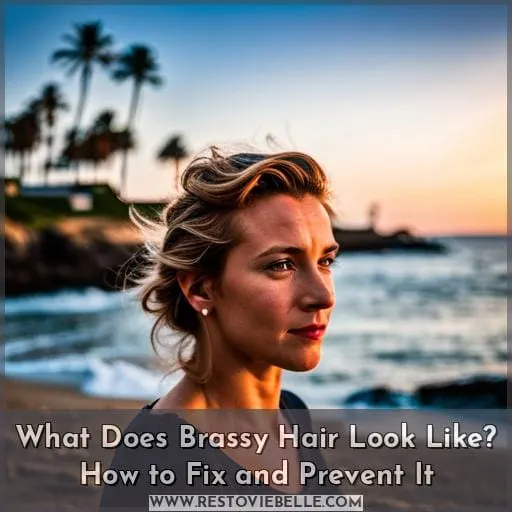 Are you wondering what brassy hair looks like? You’re not alone! If you’ve recently bleached your tresses and are now noticing some unpleasant orange or yellow hues, then the chances of having developed brassy hair are high.
Are you wondering what brassy hair looks like? You’re not alone! If you’ve recently bleached your tresses and are now noticing some unpleasant orange or yellow hues, then the chances of having developed brassy hair are high.
This can be a huge disappointment for anyone who’s taken the time to lighten their locks in pursuit of that perfect shade.
But don’t fear—with the right tips and tricks, brassiness doesn’t have to ruin your mane-game forever. Read on to learn more about how brassy blonde or brunette hair appears, why it happens in the first place, and how you can fix it with purple shampoo products as well as other treatments.
Table Of Contents
Key Takeaways
- Brassy hair results from bleaching, resulting in orange/yellow hues.
- Purple shampoo or toner can counteract yellow/orange tones.
- Dryness, coarse texture, excessive heat styling, and exposure to chlorinated/hard water can contribute to brassy hair.
- Toning treatments and deep conditioning can help correct and manage brassy hair.
Signs of Brassy Hair
Are you noticing your hair turning yellow or orange, feeling dry and coarse, requiring excessive heat styling to keep it in place, experiencing frequent exposure to chlorinated water, and living in a hard water area? If so, these are all signs of brassy hair.
Yellow or Orange Hue
You’ll be sure to notice a vibrancy of yellow and orange hues in your hair that is beyond compare, leaving you feeling like you have a sun-kissed mane! Brassy hair can occur due to bleaching or blonde coloring techniques.
Dealing with the hue requires using purple shampoo, color depositing conditioner, toning treatment, or professional advice. For best results, use clean vegan products for added protection and keep away from chlorine and UV exposure.
Dry and Coarse Texture
You may notice your hair becoming dry and coarse when it takes on a brassy hue. It can be difficult to keep locks hydrated with regular washing, so try using dry shampoo in between washes. To reduce damage from over-processing, use color-treated shampoos that are gentle on the scalp and tresses.
Consider investing in a shower filter to prevent mineral buildup, which can cause an orangish tone – plus, you’ll get great texture enhancements too! Hair moisture tips like deep conditioning treatments, avoiding harsh sulfates, and sun exposure will also help ensure long-lasting vibrant shine with no brassiness.
Excessive Heat Styling
Excessive heat styling can damage your hair, leading to brassy tones and a dry, coarse texture. Don’t fry your locks; protect them with thermal protectants and style without sacrificing healthy strands.
Alternatives include air-drying, braiding, bantu knots, diffusing on low heat settings, and rag curling. Repairing damaged hair starts with reducing orange tones using purple shampoo or toner, then restoring hydration and shine for smoothness and luster.
Frequent Chlorinated Water Exposure
Frequent chlorinated water exposure can quickly lead to brassy tones, so it’s important to be mindful of how much time you spend swimming or in the sun. Chlorine is a powerful oxidant, and its effects on hair color are quite noticeable – it causes dryness, fading, and yellow-orange undertones.
To prevent chlorine damage, use blue shampoo after each swim session and deep condition your hair regularly with natural ingredients that help restore moisture and natural pigment.
Living in a Hard Water Area
If you live in an area with hard water, the minerals it contains can lead to brassy tones. These warm undertones are caused by oxidation and mineral buildup. To combat them, use a shower filter or water softeners.
Sulfates should be avoided too! Implement purple shampoo into your hair care routine for the best results; protect against further damage with color-treated shampoos and dry shampoo on non-wash days.
How Does Brassy Blonde Hair Look?
Have you ever noticed brassy tones in your blonde hair? Brassy hair can be easily identified due to its yellow and orange hues. It’s a tell-tale sign of over-processing, sun exposure, and mineral buildup from hard water.
If maintained correctly, however, vibrant and coppery shades are achievable! To maintain brassy blonde locks, there are several tips you should include in your routine:
- Brassy Blonde Maintenance: Use purple shampoo for color neutralizing solutions. Opt for cooler toned dyes with low peroxide levels.
- Toning Techniques: Balance the usage of purple shampoo by diluting it with regular shampoo initially.
- UV Protection Tips: Stay away from chlorine pools as well as direct sunlight exposure to prevent damage or fading of color molecules in hair shafts.
- Blonde Hair Care: Opt for clean vegan products without harsh chemicals that contribute to brassiness. Use shampoos specifically designed for colored tresses. Wash every 3-5 days instead of washing frequently with lukewarm water.
- Color Neutralizing Solutions: Incorporate dry shampoos between washes. Install shower filters at home if living in an area where mineral deposits (iron/chlorine) occur naturally. Rinse off post swimming sessions immediately after leaving the pool deck, etcetera.
By following these simple steps regularly, beautiful shiny golden blondes free of warm tones will soon become a reality!
How Does Brassy Brunette Hair Look?
You might notice your brunette hair has taken on warm tones, often appearing orange or yellow. Brassy brunette hair is usually caused by over-processing, sun exposure, and heat styling but can also be a result of mineral buildup in hard water areas.
To keep brassy tones away from your dark locks, you should start by choosing the right toning techniques for color correction and an appropriate maintenance routine.
- Use purple shampoos to neutralize warm hues while keeping moisture intact.
- Deep condition to repair any damage done by chemical processes.
- Opt for sulfate-free products when washing colored hair.
- Invest in a shower filter if living in an area with high levels of iron or chlorine deposits.
- Rinse with cool water after shampooing and conditioning sessions as hot water opens up cuticles.
To maintain healthy-looking brown tresses without unwanted brassiness, choose quality vegan products that will not strip your strands of essential oils and moisture necessary for protection against environmental factors like UV rays or free radicals present inside swimming pools containing high amounts of chlorine compounds.
Make sure you follow these tips every time before going out so you don’t have to worry about dullness ruining the shine on those beautiful chocolatey locks!
Understanding the Causes of Brassy Hair
Understanding the root causes of brassy hair, from over-processing to mineral buildup, is essential for preventing unwanted warm tones. Hard water can lead to brassiness too by reacting with bleach oxidization and causing a chemical reaction that reveals yellow and red undertones in your hair.
Sun-induced brassiness occurs when UV rays interact with melanin, leading to rapid fading of color molecules. To avoid this, opt for cool-toned shades instead, as they are less likely to experience oxidation during processing or sun exposure.
Mineral buildup also has an impact on brassy hair due to its ability to create dullness and dryness while stripping away moisture and color pigments from the strands.
Toning treatments can help eliminate these issues, but if you want deeper nourishment, then invest in specific products designed specifically for color-treated locks like VoCe’s Hydrate Wash Moisture Shampoo.
Use a clarifying shampoo every so often, followed up by a deep conditioning treatment whenever you need it.
How to Fix Brassy Hair at Home
Dealing with brassy hair? Fix it right from home in a few simple steps, such as using purple shampoo and conditioner, trying a toning or glossing treatment, and re-dyeing your hair with cool-toned color.
Use Purple Shampoo and Conditioner
To combat brassy tones and keep your locks cool, try using a purple shampoo and conditioner. Purple shampoos contain pigments to neutralize warm hues in hair. Correct application is essential for best results; dilute it with regular shampoo first, then emulsify it into the scalp before rinsing off.
Look out for sulfate-free options or use blue toning shampoo if you’re brunette! The best purple conditioners help maintain color while also restoring nutrients to hair strands post-toning session.
To remove old toner from tresses, wash with clarifying shampoo followed by a deep conditioning treatment.
Try a Toning or Glossing Treatment
Feeling the sun-induced warmth of brassy tones? Balance out your hair’s color with a toning or glossing treatment.
Benefits include restoring vibrance, protecting from future damage, adding shine and depth.
Professional advice is best to ensure no further discoloration. DIYers can use semi-permanent dyes and toners to achieve the desired look.
Toning and glossing treatments both work towards reducing brassiness. Toner works faster but fades quicker, while a glossy finish lasts much longer when done correctly!
Get ready for smooth, shimmery locks by giving your tresses some tender loving care today!
Re-dye With Cool-Toned Color
If you’re looking to tone down the brassiness, try switching up your color with a cool-toned dye job! Professional colorists can help correct and restore your hair back to its original state. But if you’d like to do it yourself at home, there are DIY toning methods that can be used.
Start by choosing the right products for your needs; look for those specifically formulated for toning or cooling hues in order to prevent any further damage. You’ll also need shampoo without sulfates and a shower filter that reduces mineral buildups from hard water, which could lead to brassy tones as well.
When re-dyeing, use a cool water rinse instead of hot water in order to revive color tones. Then apply conditioner afterward so cuticles remain closed, preventing fading away quickly after each wash cycle.
Proper hair care is key here. Avoid sun exposure and chlorinated pools when possible, while using dry shampoos on non-wash days will help keep oil buildup under control too! With these tips combined correctly, you should find success in restoring the balance between warm and cool shades of colors soon enough!
Is Purple Shampoo the Only Solution?
Although purple shampoo is a popular solution for brassy hair, there are other ways to combat warm tones. Toning your hair can be an effective way to maintain cool tones and create the vibrant, shiny coppery look you desire.
You can DIY tone with pastel pink hues or use professional toners that won’t damage your hair as much as bleach-based products. Alternatives to purple shampoo include seeking out clean beauty options such as VoCe Hydrate Wash Moisture Shampoo, which contains shea butter, white tea, and vanilla cactus for a protective moisture barrier.
Another option is the Smoothing Set, which has tamanu seed oil, Buriti oil, and passion fruit ingredients. Additionally, you can try the Color Balance Purple Conditioner from Matrix Biolage, which deposits color pigments onto the surface of each strand while nourishing it at the same time.
To prevent UV exposure damage in between toning treatments, try using leave-in sun protection sprays on dry days or donning a scarf when spending extended periods outdoors.
With these tips in mind, you’ll be able to keep brassiness away without having to rely solely upon purple shampoo every day.
How to Prevent Brassy Hair
It’s time to take control of your hair and prevent the dreaded brassy tones! Choose colors that are cooler-toned, avoid pool and sun exposure, use shampoos without sulfates, opt for color-treated shampoo specifically designed for colored hair, and make sure you choose clean beauty products.
Choose the Right Hair Color
Choosing the right hair color can help you avoid warm tones and maintain your desired look. Match colors to skin tone, stay on trend with professional advice, or maintenance techniques like a cold water rinse and avoiding swimming pools.
Vegan beauty products such as VoCe’s Smoothing Set are also recommended for nourishing hair, while shampoo frequency should be reduced to prevent brassiness.
Avoid Pool and Sun Exposure
Shield your hair from the sun’s harsh rays and pool chemicals to protect against unwanted warmth in color. Sun protection is key for maintaining vibrant, shiny hues! Chlorine and UV damage can quickly strip away color, leaving it dry and coppery.
For summer hair care tips, use a hat or scarf when outdoors; wet your locks before swimming; rinse with cool water afterward.
Use Shampoo Without Sulfates
To prevent brassiness, choose sulfate-free shampoos. They maintain hair color and moisture while providing nourishing benefits. Look for moisturizing ingredients such as shea butter, tamanu seed oil, or buriti oil to ensure maximum protection against fading and dryness.
Use Shampoo for Color-Treated Hair
Opt for a shampoo specifically designed for color-treated hair to lock in your perfect shade and keep unwanted brassy tones at bay. Clarifying shampoos help remove mineral deposits, while conditioner can make up for any lost moisture, so choose wisely! Top brands offer UV protection that helps preserve the vibrancy of your locks.
Dealing with hard water? Use products designed to protect against chemical reactions from chlorine or iron buildup.
Opt for Clean Beauty Products
Choose clean, vegan products to help protect your hair and prevent unwanted warm tones. Natural ingredients from sustainable beauty brands give chemical-free hair care that’s eco-friendly too! Enjoy the Clean Beauty Benefits of pure botanicals with no synthetic dyes or fragrances.
How Does Toner Affect Your Hair?
Treat your tresses to a toning treatment for a sensational shade! Toner is an effective way to keep hair healthy and prevent brassiness. When incorporated into the coloring process, it can help correct color mistakes or unwanted warm tones in colored hair.
There are several varieties of toner available depending on the desired effect:
- Hair Health: Revive damaged strands with protein-rich formulas that strengthen and protect while refreshing color.
- Toning Process: Neutralize brassy hues by using purple pigments that counter yellow/orange tones due to natural oxidation over time.
- Color Correction: Brighten existing shades or add subtle highlights without damage caused by bleaching, peroxide, or ammonia treatments used in traditional dyes.
- Toner Maintenance: Reapply every 5–7 weeks as needed; use sulfate-free products between treatments for best results.
The right toner can enhance vibrancy and shine while keeping locks looking nourished, hydrated, and polished! So why not embrace copper perfection? Investing in professional-grade products will ensure optimal benefits with minimal effort—no more worry about orangey undertones peeking through! Get ready to show off glossy waves full of depth, dimension, and texture all year round!
Removing Hair Toner
Glistening in the sun with a vibrant, coppery shine: that’s what brassy hair looks like. To remove hair toner and its effects on your mane, use clarifying shampoo and a deep conditioning treatment to restore it back to its original state.
Wash With Clarifying Shampoo
To remove hair toner, start by washing your locks with a clarifying shampoo to strip away any unwanted color. A good clarifying shampoo can provide many benefits for different hair types, from removing mineral buildup to restoring vibrancy and shine.
When choosing a clarifying shampoo, look for one that’s specifically designed for the type of hair you have. For example, if you have dry or damaged hair, opt for one that’s sulfate-free and contains nourishing ingredients like avocado oil or shea butter.
It’s important not to overuse these shampoos as they tend to be quite harsh on the scalp. Once every two weeks should suffice, unless needed more often due to sweating in hot climates or frequent swimming in chlorinated pools.
Clarify those tresses today and enjoy lusciously healthy locks!
Deep Conditioning Treatment
Give your hair a boost of nourishment with a deep conditioning treatment! A great way to restore hydration and shine, this type of treatment can help protect from damage caused by heat styling or harsh environmental factors.
Here are five key benefits:
- Benefits of Conditioning: Replenishes lost moisture, repairs split ends, and strengthens strands.
- Deep Treatment Techniques: Hot oil treatments provide intense moisturizing for dry hair.
- Moisturizing Benefits: Provides long-lasting hydration that prevents frizz and breakage while improving elasticity and manageability.
- Best Conditioners: Look for products containing natural oils like argan or coconut as they penetrate the cuticle layer better than synthetic ones.
- DIY Hair Treatment: Create your own conditioner at home using yogurt, honey, olive oil, banana mash, mayonnaise mix, etc.
Give yourself an invigorating deep conditioning session today to enjoy healthier-looking locks!
Conclusion
When it comes to brassiness, it’s easy to feel helpless and lost. But with the right knowledge and tools, you can make your hair look vibrant and coppery once again.
When dealing with brassy hair, understanding what it looks like is the first step.
To fix it, you can opt for purple shampoo and conditioner, a toning or glossing treatment, or re-dye with a cool-toned color. It’s also important to choose the right hair color, avoid pool and sun exposure, use shampoo without sulfates, and opt for clean beauty products.
Toner can also help, but make sure to remove it properly with a clarifying shampoo and deep conditioning treatment.
